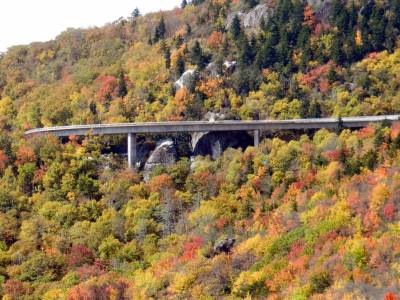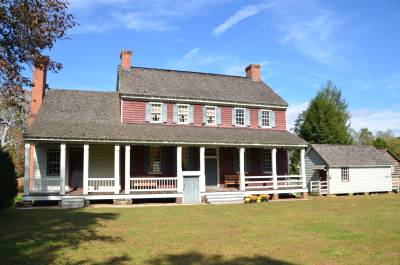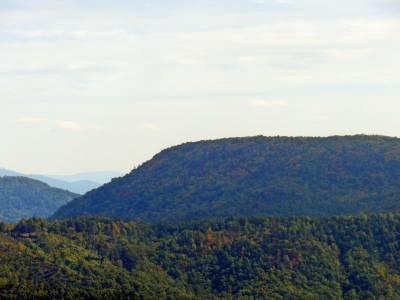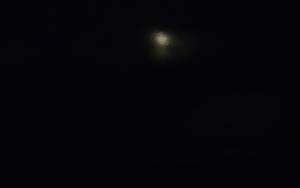Mysterious lights and more
Yet another sightseeing day, this time
from my new base in Wilkesboro. Blue Ridge Parkway, Tom Dooley and Brown
Mountain was on todays program. From Wilkesboro I took U.S. 421 to Boone, and there I entered the parkway heading north. The goal was the
North West Trading Post, which we last visited in 2002. Weather was great all
day, the sun was shining from an almost cloudless sky and it was warm as well,
25° celsius, that is around 77° F,
and only a little haze, so I took some pictures up on the park road, and here
the autumn colors were far more visible than in Great Smoky Mountains NP.
 I visited the store and bought
a bottle of water - on this trip I had not, as we customarily do, bought a cooling
box, as I would only be awaY for a week - and would normally be within reach
of a gas station or store, where I could get water. Instead I had chosen to buy a single, cold
bottle of water whenever I needed it, which was typically once or twice a day,
depending on temperature and activities. In addition to water I also bought a
few gifts to take home to the family. When done at Northwest Trading Post, I
headed south. Before I left the place however, I just took a few pictures of the
fences that is so characteristic for The Appalaches. My next stop I made at the
overlook "The Lump" a few miles to the south of the trading post. This is where
you find the "famous" sign telling about Tom Dooley -
the sign that aroused my interest in the Dooley case. As on several previous
occasions the sign was photographed, even from multiple angles.
I visited the store and bought
a bottle of water - on this trip I had not, as we customarily do, bought a cooling
box, as I would only be awaY for a week - and would normally be within reach
of a gas station or store, where I could get water. Instead I had chosen to buy a single, cold
bottle of water whenever I needed it, which was typically once or twice a day,
depending on temperature and activities. In addition to water I also bought a
few gifts to take home to the family. When done at Northwest Trading Post, I
headed south. Before I left the place however, I just took a few pictures of the
fences that is so characteristic for The Appalaches. My next stop I made at the
overlook "The Lump" a few miles to the south of the trading post. This is where
you find the "famous" sign telling about Tom Dooley -
the sign that aroused my interest in the Dooley case. As on several previous
occasions the sign was photographed, even from multiple angles.
From The Lump I continued
south past Boone, where I had started, and past Blowing Rock, where I did not
stop this time. At Linn Cove Viaduct, I took a few pictures that were reasonably
OK, although there was now much more haze than erarlier in the day. When
I reached North Carolina Road 181, I left the parkway and headed southeast. On the way southeast
you pass a rest area, with a view of
Brown Mountain, and here I made a stop. My plan was to visit this rest area in the evening, and to be
sure to be able to find my way there in the darkness, I stored the location
in my gps, before continuing.
I continued along the highway down to I-40, which I then took east to
the town of Hickory. From there I headed back north towards Lenoir, the county
seat of Caldwell County. From then on Tom Dooley was the theme of the
afternoon exercises. I could have used a more direct route taking small byways, but
at the time I just
needed to get a move on after driving 35 and 45 mpt on Blue Ridge Parkway - thus
the interstate. From
Lenoir I took NC Road 268, the road that is the center of Tom Dooley story, even if it did not exist in 1866.
The explanation is that the road runs
straight through the relevant area. First I refueled though - gas
for the car and more water for me. I visited a gas station in a small gathering of
houses with no name, not far from Patterson. Here I also took a
few pictures of the wider part of the Yadkin River Valley with one of the barns
that are so normal in USA, but are rather rare in Denmark. We call them "Grandma
Duck barns", because her farm has one of those in the Donald Duck comics. Along the way I passed
a "Historical Marker" for General William Lenoir and another
for General Collett Leventhorp. Lenoir was an officer in the
American Revolution, and Leventhorpe during the Civil War.
 In 2012, Tim and I had passed a small dirt road that led up to Fort Defiance,
the former home of General William Lenoir, the man from the historical marker. When I got to the road
I decided for a visit this time so I headed up the road, and it turned
out to lead up to a nice big house - and an office. The place
was open (the office that is) and a lady was busy negotiating with a couple of
guys, whether their motor club could borrow her lawn for a camping trip a few months
later - which they could. When she was finished with them, it was my turn and
we got a nice chat anf she told me about the general and his 1792 home, which I was content, however,
to look at only from the outside. But I visited the family cemetery behind the house where members of the
Lenoir family (with spouses , etc.) have been buried since the general himself, as the
first was laid in the ground, and the last burial was in 2000. My guess is that
there were about 100 - 150 people buried at the site and it was very interesting.
After visiting the cemetery, I returned to the office and talked further with
the lady who obviously would like to know where I came from? When she heard that I was
Danish, she would like to know what I was doing there, right out in a secluded part North Carolina?
In 2012, Tim and I had passed a small dirt road that led up to Fort Defiance,
the former home of General William Lenoir, the man from the historical marker. When I got to the road
I decided for a visit this time so I headed up the road, and it turned
out to lead up to a nice big house - and an office. The place
was open (the office that is) and a lady was busy negotiating with a couple of
guys, whether their motor club could borrow her lawn for a camping trip a few months
later - which they could. When she was finished with them, it was my turn and
we got a nice chat anf she told me about the general and his 1792 home, which I was content, however,
to look at only from the outside. But I visited the family cemetery behind the house where members of the
Lenoir family (with spouses , etc.) have been buried since the general himself, as the
first was laid in the ground, and the last burial was in 2000. My guess is that
there were about 100 - 150 people buried at the site and it was very interesting.
After visiting the cemetery, I returned to the office and talked further with
the lady who obviously would like to know where I came from? When she heard that I was
Danish, she would like to know what I was doing there, right out in a secluded part North Carolina?
I then explained that I had visited the area several times and was very fond of
both the nature and the people - and I also told her of my interest in Tom Dooley. She
then asked me if I had visited Whippoorwill Academy and I could tell her that
I had been there a few times and would visit again the next day (the museum is only open on Saturday and Sunday afternoons). Just before I had to go, she asked if I had seen Laura Foster's grave. I could
confirm this but only from the road as the grave is on private land and is
fenced in behind an electric fence,, as it is in a field where there usually are
cows. She, however, could tell that right in those days, neither cows in the
field nor
current in the fence were present, so I should go in there - and the owner was a nice man who
wouldn't mind.
When I arrived at Laura's grave, I parked the car on the short
cul-de-sac on the other side of the road, where you find a memorial to Laura
Foster. Here I left the car behind, crossed the road and could see that the gate to the field was open, so I got
the chance to get close to the grave and take some pictures. After the visit
here, I drove around to several of the sites of the Dooley case, eg Grandin (where Tom's
nemesis, James Isbell had lived), Gladys Fork Road, where I once again visited
Ann Melton's grave, and tried to locate the cemetery where
her brother should be buried, but with no luck. I also tried to locate Bates place, where the murder took place.
For this I came up with two options, bu tI don't know which one is correct
if either - and no one else knows either, as the
exact place seems to have passed into oblivion. Also a few of the local churches got my
attention and finally I tried once again to locate Tom's own grave - and once
again without any luck.
Therefore
I headed home to the hotel and relaxed for about an hour before going out for
dinner. After dinner it was time to visit
Brown Mountain, or rather the look out I had visited earlier in the day. So
what is so interesting about Brown Mountain, since I wanted to go there at night? The mountain or rather the ridge itself is nothing special. It is about
a mile and a half long
and approx. 2.300 feet high, so it doesn't look likemuch. The mountain, however, is famous for the mysterious
lights that from time to time can be seen on, above and around it. The lights
became very well known
in the early 1900s,
 but local Indians had known them for at least 200 years
before that, and Cherokee legends remember them back to about 1200. The lights
are a fact but what
causes them has yet to be scientifically explained, although a lot of different
explantions have been given. Among these are headlights from trains or cars
heading towards the viewer. This explanation is, however, undermined by the fact that the lights were seen long before trains and
cars were invented, and the lighrs were also seen in a period when all train and car traffic was stopped due to a flooding
of the area, that had torn down all bridges. Lights from the cities on the
other side of the mountain, burning swamp gasses, radioactive emission from radium
in the mountain and several other explanations have been tried, but they have all been rejected
after they have been put forward. Also, the United States Geological Society
has investigated the lights but without finding the definitive explanation.
but local Indians had known them for at least 200 years
before that, and Cherokee legends remember them back to about 1200. The lights
are a fact but what
causes them has yet to be scientifically explained, although a lot of different
explantions have been given. Among these are headlights from trains or cars
heading towards the viewer. This explanation is, however, undermined by the fact that the lights were seen long before trains and
cars were invented, and the lighrs were also seen in a period when all train and car traffic was stopped due to a flooding
of the area, that had torn down all bridges. Lights from the cities on the
other side of the mountain, burning swamp gasses, radioactive emission from radium
in the mountain and several other explanations have been tried, but they have all been rejected
after they have been put forward. Also, the United States Geological Society
has investigated the lights but without finding the definitive explanation.
The latest explanation I've seen is based on the fact that the mountain contains large
amounts of quartz. It is also surrounded by faults on three sides, and when
these faults are moving, pizoelectric charges are generated in the quarz. These
charges ignites small "lumps" of plasma, which then moves around, up and down, back and forth for a
short time before dissolving. This could explain the behavior of the lights,
as they have been reported moving across the hillside, up and down this, and
occasionally the lights rises above the mountain before they disappear. Usually, the lights
are
only visible for between five and ten seconds even if some lasting for up to a
minute
or more has been observed occasionally. Some people claim to have been close to a light,
and that this then moved away from them, which would (the theory goes) be consistent with the plasma
being repelled by the person's electromagnetic field.
A few claim to even have touched a light, and that they had felt pain similar to an
electric shock. These postulates were made before the plasma theory was aired.
Personally though, I
prefer the more romantic explanation of the Cherokees.
Around year 1200 the tribe fought a great battle against the neighboring
Catawba tribe in
wshat is now Pisgah National Forest, where also Brown Mountain is located. Many on
both sides were killed, but the Cherokees won the battle. After the battle young
girls from the tribe went out to look for the missing warriors, and it is the light of their
lamps, which can still be seen when their departed spirits searches for their
loved ones. Come again science!
Well, that was the reason I wanted to go to the deserted rest
area in the dark.
The lights should be most visible in October and November, some says that the
lights are mostly seen after rain, and
they usually should be most visible between 10 pm and 2 am. Others maitain that
thre lights can be seen all night, all year and no matter the weather conditions. As mentioned earlier,
I had stored the address in my navigation unit and now I asked it to show me the way. And I can tell
you that I got on a sightseeing trip. Except that I could not see anything because of the
darkness. But it took me along very small and narrow roads where I didn't want
to drive fast in the darkness. It turned out to be a good decision, because at
some point a deer jumped out on the road right in front of me, and had I been
going 35 instead of the 25 mpt I did, I would have hit it. In fact, I
never see so much roadkill as on this trip, but I managed to avoid hitting
anything. Although there is only approx. 35 miles from Wilkesboro to the
look out, it took me almost two hours to get there. When I arrived there at
8.45 and I was not the only one who had had the same bright idea. There were four or five cars
in the parking lot, two of which had kept their headlights on, which is not
smart when you want to see weak lights in the dark. Fortunately, both left and
so did most of the other cars, and I was left alone with a single guy armed with
a camera on a
tripod. Of course we started to chat. I have forgotten his name but he
was a professional photographer from Morgantown and had studied the lights since
1999. Just in the week when I met him on Friday night, he had already
spent about 40 hours on this deserted rest area. The camera was an ordinary
SLR with a large and very light-sensitive tele lens. While we chatted he showed me some pictures that he had
taken on Wednesday. He had been there Thursday as well, but because of the rain
that kept me completely away, he hadn't gotten any
pictures. The pictures he showed
me,
clearly showed moving lights on the hillside. The movement was obvious as the lights were partially blurred
while the background was sharp, and he insisted that they
were genuine and not
made in Photoshop. While we chatted several cars arrived and left again, and
the photographer
 thought that people did not have any patience. The lights are
not seen every day, but we hoped that the rain the previous day might "drag them out".
thought that people did not have any patience. The lights are
not seen every day, but we hoped that the rain the previous day might "drag them out".
I
stayed at the look out until around midnight, and then I headed back to the hotel.
The photographer would remain for a few hours more. While I was there, we saw four
lights, two of which were questionable (according to my expert), they could very well be
light from cars as they were visible for a relatively long time. One was likely
and one was definitely a Brown Mountain Light. You should be aware, the
photographer told me that the bear hunting season had just started so many
hopeful hunters
were wandering around on the mountain with flashlights.
I tried to take pictures of the lights but my camera was simply not good enough. They
were all completely black, except for the one on the left which shows a small
smeared light, which could be almost anything. On the way home I gave up on the small roads and took
the slightly larger NC Highways to Boone and then back to Wilkesboro along U.S. 421.
It was around 1.15 am, when I got back to the hotel, so I granted myself a little
more time to rest , and sat the alarm to wake me up at 8. The program for the next day would be more the
Blue Ridge Parkway and a visit to Whippoorwill Academy etc.
- Return to Alone in Fall -
- Return to Travel page -